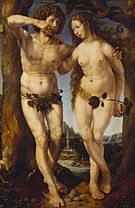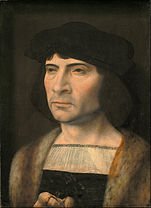Jan Gossaert


Jan Gossaert (c. 1478 – 1 October 1532) was a French-speaking painter from the Low Countries also known as Jan Mabuse (the name he adopted from his birthplace, Maubeuge) or Jennyn van Hennegouwe (Hainaut), as he called himself when he matriculated in the Guild of Saint Luke, at Antwerp, in 1503.[1] He was one of the first painters of Dutch and Flemish Renaissance painting to visit Italy and Rome, which he did in 1508–09, and a leader of the style known as Romanism, which brought elements of Italian Renaissance painting to the north, sometimes with a rather awkward effect. He achieved fame across at least northern Europe, and painted religious subjects, including large altarpieces, but also portraits and mythological subjects, including some nudity.
From at least 1508 he was apparently continuously employed, or at least retained, by quasi-royal patrons, mostly members of the extended
He was a contemporary of Albrecht Dürer and the rather younger Lucas van Leyden, whom he knew, but he has tended to be less highly regarded in modern times than they were. Unlike them, he was not a printmaker, though his surviving drawings are very fine, and are preferred by some to his paintings.[3]
Biography
His name was in fact "Jan Gossart", and he was so known in his lifetime; the Dutch version "Gossaert" crept into later sources, despite Gossart's first language being French.
In 1508-9 he travelled to Rome, either in the company of, or later sent by,
In 1509–17 Gossaert was registered as a resident of Middelburg.[6] According to Van Mander he was one of the first Flemish artists to bring back the Italian manner of painting with much nudity in historical allegories.[5] From 1517 to 1524 he is registered at Duurstede Castle where according to the RKD, he had Jan van Scorel as pupil.[6] From 1524 onwards he returned to Middelburg as court painter to Adolf of Burgundy,[6] another Habsburg relative. Jan Mertens the Younger was another pupil.
He was a contemporary of Lucas van Leyden,[5] and was influenced by artists who came before him, such as Rogier van der Weyden, the great master of Tournai and Brussels and, like him, his compositions were usually framed in architectural backgrounds.[1]
Works
Gossaert shows Antwerp influence in the large altar-pieces previously located at Castle Howard and Scawby. At Scawby he illustrates the legend of the count of Toulouse, who parted with his worldly goods to assume the frock of a hermit.[1] His altarpiece of the Descent from the Cross with heavy double doors in Middelburg was admired by Albrecht Dürer before the church itself was hit by lightning.[5] This is possibly the work now in the Hermitage,[8] though Van Mander stated the lightning destroyed it and describes another Descent of the Cross in the possession of Mr. Magnus of Delft in 1604.

At Castle Howard, the
Philip of Burgundy ordered Gossaert to execute a replica for the church of Middelburg, and the value which was then set on the picture is apparent from the fact that Dürer came expressly to Middelburg (1521) to see it. In 1568 the altarpiece perished by fire. In 1508 Gossaert accompanied Philip of Burgundy on his Italian mission to the pope, and by this accident an important revolution was effected in the art of the Netherlands. Gossaert appears to have chiefly studied in Italy the cold and polished works of the Leonardesques. He not only brought home a new style, but he also introduced the fashion of travelling to Italy; and from that time until the age of
Gossaert undoubtedly made a large number of drawings in Rome after the innumerable ancient ruins and sculptures that the city had. Today only four surviving magazines are known; a sheet with the ruins of the Colosseum (Berlin, Kupferstichkabinett), a study of the so-called Apollo Kitharoedos (Venice, Accademia), a study of the so-called Capitolean Hercules (Private collection, London), and a sheet with studies of, among others, the famous Spinario[9] or "thorn extractor" (Leiden, Leiden University Library's Print Room).
In the summer of 1509 Philip returned to the Netherlands, and, retiring to his seat of Suytburg in

But his only signed pictures of this period are the Neptune and Amphitrite of 1516 at Berlin, and the Madonna, with a portrait of
Happily, Gossaert was capable of higher efforts. His St Luke painting the portrait of the Virgin in Sanct Veit at Prague, a variety of the same subject in the Belvedere at Vienna, the Madonna of the Baring collection in London, or the numerous repetitions of Christ and the scoffers (Ghent and Antwerp), all prove that travel had left many of Gossaert's fundamental peculiarities unaltered. His figures still retain the character of stone; his architecture is as rich and varied, his tones are as strong as ever. But bright contrasts of gaudy tints are replaced by soberer greys; and a cold haze, the
As early as 1523, when
At the period when these portraits were executed Gossaert lived at

-
Drawing of Virgin and Child with Saints, c. 1511
-
Hercules and Deianira, 1517
-
Floris van Egmond, 1519
-
Adam and Eve c. 1520, Royal Collection
-
Danae, (1527)
-
Portrait of Francisco de los Cobos y Molina, 1530
-
Isabella of Spain and Denmark
-
Portrait of a Merchant, c. 1530
-
A Young Princess (Possibly Dorothea of Denmark) 1530
-
The Virgin and Child with white lilies and cherries, c. 1530
-
Portrait of a Man, (1493-1532)
-
Christ between the Virgin and Saint John the Baptist,Prado Museum, Madrid.
Notes
- ^ a b c d e f g h i j k l Crowe 1911.
- ^ Campbell, 1–3
- ^ Cummings, Laura, Jan Gossaert's Renaissance Review in The Guardian of the National Gallery exhibition, London and Washington, 2011
- ^ a b Campbell, 1
- ^ Digital library for Dutch literature
- ^ a b c d e 32898 artist record for Jan Gossaert in RKD
- ^ Campbell, 2
- ^ 56051 in the RKD
- ^ Gosssart's Spinario has been selected by CODART as one of the hundred masterpieces in the book 100 Masterpieces Dutch and Flemish Art 1350-1750 – CODART Canon. The drawing can be viewed in Leiden University Library's Digital Collections
- Digital library for Dutch literature
References
- Campbell, Lorne, "Biography – Jan Gossaert (Jean Gossart)" Archived 16 April 2016 at the Wayback Machine, National Gallery, London
- This article incorporates text from a publication now in the public domain: Crowe, Joseph Archer (1911). "Mabuse, Jan". In Chisholm, Hugh (ed.). Encyclopædia Britannica. Vol. 17 (11th ed.). Cambridge University Press. p. 189.
Further reading
- ISBN 1588393984 9781588393982, fully online
- ISBN 0136235964
- Nadine M. Orenstein, 'Jan Gossaert's Mocking of Christ: A Reversal of States', Print Quarterly, XXVIII, 2011, 249–55
- Bass, M. A. (2016). Jan Gossart and the invention of Netherlandish antiquity. Princeton University Press.
External links
 Media related to Jan Gossaert at Wikimedia Commons
Media related to Jan Gossaert at Wikimedia Commons- 7 full catalogue entries from the National Gallery, London, by Lorne Campbell
- Works and literature at PubHist













